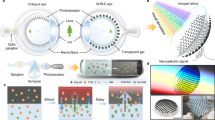Abstract
During visual excitation, rhodopsin undergoes photoactivation and bleaches to opsin and all-trans-retinal1,2. To regenerate rhodopsin and maintain normal visual sensitivity, the all-trans isomer must be metabolized and reisomerized to produce the chromophore 11-cis-retinal in biochemical steps that constitute the visual cycle and involve the retinal pigment epithelium (RPE; refs. 3–8). A key step in the visual cycle is isomerization of an all-trans retinoid to 11-cis-retinol in the RPE (refs. 9–11). It could be that the retinochrome-like opsins, peropsin, or the retinal G protein-coupled receptor (RGR) opsin12–16 are isomerases in the RPE. In contrast to visual pigments, RGR is bound predominantly to endogenous all-trans-retinal, and irradiation of RGR in vitro results in stereospecific conversion of the bound all-trans isomer to 11-cis-retinal17. Here we show that RGR is involved in the formation of 11-cis-retinal in mice and functions in a light-dependent pathway of the rod visual cycle. Mutations in the human gene encoding RGR are associated with retinitis pigmentosa18.
This is a preview of subscription content, access via your institution
Access options
Subscribe to this journal
Receive 12 print issues and online access
$209.00 per year
only $17.42 per issue
Buy this article
- Purchase on Springer Link
- Instant access to full article PDF
Prices may be subject to local taxes which are calculated during checkout






Similar content being viewed by others
References
Wald, G. The molecular basis of visual excitation. Nature 219, 800–807 (1968).
Stryer, L. Molecular mechanism of visual excitation. Harvey Lect. 87, 129–143 (1991–1991).
Hubbard, R. & Wald, G. Cis-trans isomers of vitamin A and retinene in the rhodopsin system. J. Gen. Physiol. 36, 269–315 (1952).
Dowling, J.E. Chemistry of visual adaptation in the rat. Nature 163, 114–118 (1960).
Zimmerman, W.F. The distribution and proportions of vitamin A compounds during the visual cycle in the rat. Vision Res. 14, 795–802 (1974).
Bridges, C.D.B. Vitamin A and the role of the pigment epithelium during bleaching and regeneration of rhodopsin in the frog eye. Exp. Eye Res. 22, 435–455 (1976).
Redmond, T.M. et al. Rpe65 is necessary for production of 11-cis-vitamin A in the retinal visual cycle. Nature Genet. 20, 344–351 (1998).
Saari, J.C. Biochemistry of visual pigment regeneration. Invest. Ophthalmol. Vis. Sci. 41, 337–348 (2000).
McBee, J.K. et al. Isomerization of all- trans -retinol to cis-retinols in bovine retinal pigment epithelial cells: dependence on the specificity of retinoid-binding proteins. Biochemistry 39, 11370–11380 (2000).
Deigner, P.S., Law, W.C., Cañada, F.J. & Rando, R.R. Membranes as the energy source in the endergonic transformation of vitamin A to 11- cis -retinoid. Science 244, 968–971 (1989).
Rando, R.R. Membrane phospholipids and the dark side of vision. J. Bioenerg. Biomembr. 23, 133–146 (1991).
Ozaki, K., Hara, R., Hara, T. & Kakitani, T. Squid retinochrome. Configurational changes of the retinal chromophore. Biophys. J. 44, 127–137 (1983).
Sun, H., Gilbert, D.J., Copeland, N.G., Jenkins, N.A. & Nathans, J. Peropsin, a novel visual pigment-like protein located in the apical microvilli of the retinal pigment epithelium. Proc. Natl. Acad. Sci. USA 94, 9893–9898 (1997).
Jiang, M., Pandey, S. & Fong, H.K.W. An opsin homologue in the retina and pigment epithelium. Invest. Ophthalmol. Vis. Sci. 34, 3669–3678 (1993).
Pandey, S., Blanks, J.C., Spee, C., Jiang, M. & Fong, H.K.W. Cytoplasmic retinal localization of an evolutionary homolog of the visual pigments. Exp. Eye Res. 58, 605–614 (1994).
Hao, W. & Fong, H.K.W. Blue and ultraviolet light-absorbing opsin from the retinal pigment epithelium. Biochemistry 35, 6251–6256 (1996).
Hao, W. & Fong, H.K.W. The endogenous chromophore of retinal G protein-coupled receptor opsin from the pigment epithelium. J. Biol. Chem. 274, 6085–6090 (1999).
Morimura, H., Saindelle-Ribeaudeau, F., Berson, E.L. & Dryja, T.P. Mutations in RGR, encoding a light-sensitive opsin homologue, in patients with retinitis pigmentosa. Nature Genet. 23, 393–394 (1999).
Chen, P., Lee, T.D. & Fong, H.K.W. Interaction of 11- cis -retinol dehydrogenase with the chromophore of Retinal G. protein-coupled Receptor opsin. J. Biol. Chem. Papers in Press, published March 27, 2001.
Tao, L. et al. Structure and developmental expression of the mouse RGR opsin gene. Mol. Vis. 4, 25 (1998).
Groenendijk, G.W.T., De Grip, W.J. & Daemen, F.J.M. Identification and characterization of syn- and anti-isomers of retinaloximes. Anal. Biochem. 99, 304–310 (1979).
Groenendijk, G.W.T., De Grip, W.J. & Daemen, F.J.M. Quantitative determination of retinals with complete retention of their geometric configuration. Biochim. Biophys. Acta 617, 430–438 (1980).
Ozaki, K., Terakita, A., Hara, R. & Hara, T. Rhodopsin and retinochrome in the retina of a marine gastropod, Conomulex luhuanus. Vision Res. 26, 691–705 (1986).
Landers, G.M. High-performance liquid chromatography of retinoid isomers. Methods Enzymol. 189, 70–80 (1990).
Alpern, M. Rhodopsin kinetics in the human eye. J. Physiol. (Lond.) 217, 447–471 (1971).
Acknowledgements
We thank A. Mendez for advice about ES cell culture, A. Nagy for the gift of R1 ES cells and L. LaBree for work on statistical analysis of data. This work was supported by grants from the Hoover Foundation and the U.S. Public Health Service (EY08364 and EY03040).
Author information
Authors and Affiliations
Corresponding author
Rights and permissions
About this article
Cite this article
Chen, P., Hao, W., Rife, L. et al. A photic visual cycle of rhodopsin regeneration is dependent on Rgr. Nat Genet 28, 256–260 (2001). https://doi.org/10.1038/90089
Received:
Accepted:
Issue Date:
DOI: https://doi.org/10.1038/90089
This article is cited by
-
Non-visual Opsins and Novel Photo-Detectors in the Vertebrate Inner Retina Mediate Light Responses Within the Blue Spectrum Region
Cellular and Molecular Neurobiology (2022)
-
The rhodopsin-retinochrome system for retinal re-isomerization predates the origin of cephalopod eyes
BMC Ecology and Evolution (2021)
-
Morphology and genome of a snailfish from the Mariana Trench provide insights into deep-sea adaptation
Nature Ecology & Evolution (2019)
-
The crowns have eyes: multiple opsins found in the eyes of the crown-of-thorns starfish Acanthaster planci
BMC Evolutionary Biology (2018)
-
An all-trans-retinal-binding opsin peropsin as a potential dark-active and light-inactivated G protein-coupled receptor
Scientific Reports (2018)



